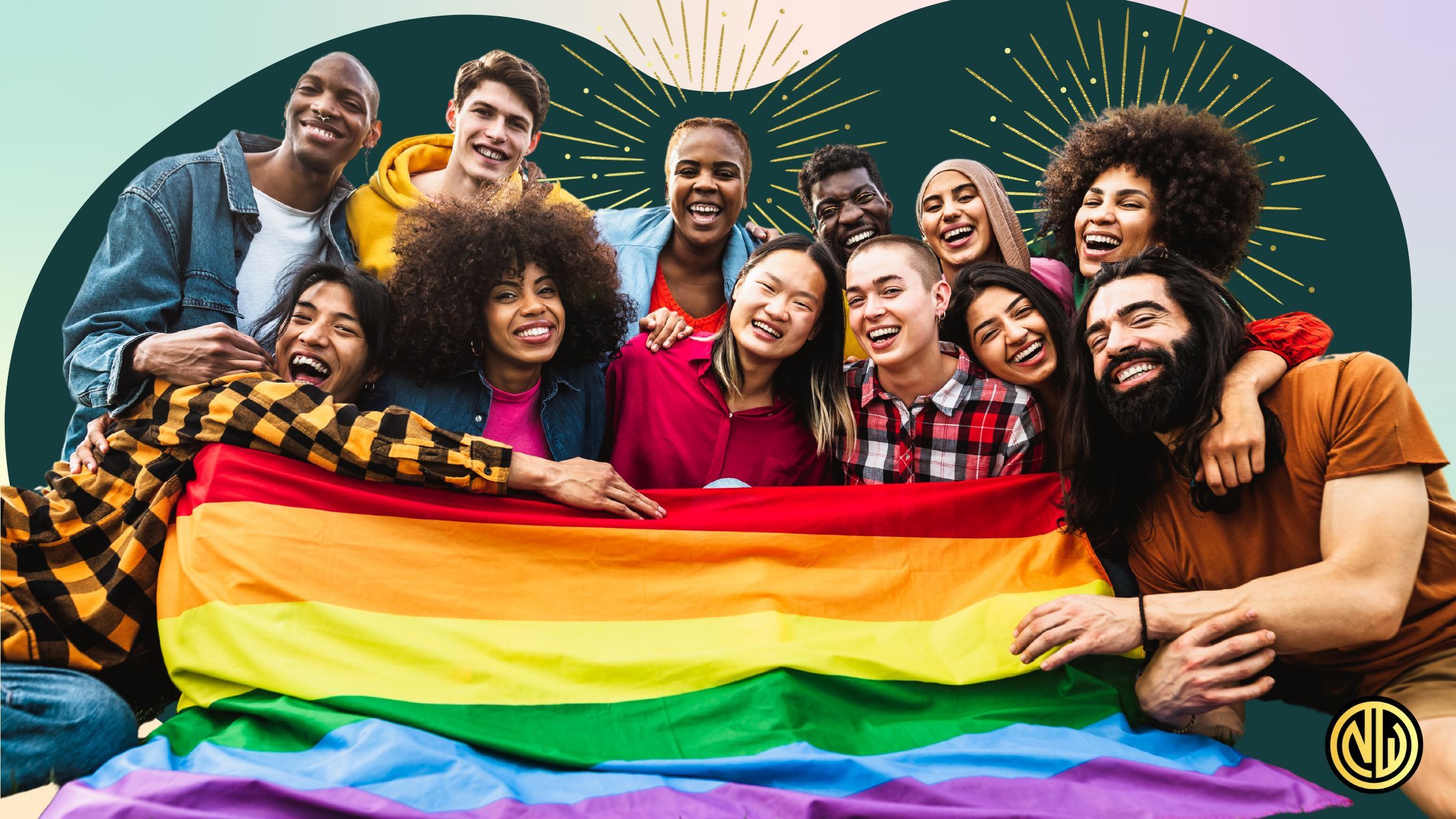There are over 20 million LGBTQ+ adults in America. About 8% of the overall population identifies as LGBTQ+, and these self-identification numbers are higher for younger generations -- 9.8% for millennials and 22.3% for generation Z -- a March 2024 Gallup poll found.
We don't have a lot of data on queer people's financial habits. Historically, the U.S. Census Bureau has not asked sexual orientation and gender identity (SOGI) questions on its surveys, so there are information gaps on LGBTQ+ socioeconomic status compared to women, people of color, geography and age. Not cute.
This might be changing soon, though. The Census has asked the White House Office of Management and Budget to start including SOGI questions in the American Community Survey, one of its main surveys that polls 3.5 million Americans each year, and is expected to begin in August 2024. This will be huge, actually: It will transform LGBTQ+ visibility in America and help shape policy reform.
Until then, think tanks and not-for-profit organizations have been plugging the data gap for more than two decades. The research they have produced paints a picture about how queer people navigate personal finance; a selection of those data sets is below, and this article is updated regularly with new research.
When we equip ourselves with financial knowledge, we’re better prepared to start taking action. Here are some of the most important facts and figures to know about LGBTQ+ financial wellness.
Table of Contents
Financial Challenges Experienced by Queer People
Although LGBTQ+ people have won additional legal protections in recent years, there are still several factors that can impact our financial planning and well-being. Here are the big ideas to know before we jump into specific statistics.
- Lower earning potential. There is an LGBTQ+ wage gap, which puts us behind from the start, and the gap is larger for queer people who have intersectional identities.
- Housing discrimination. The Fair Housing Act of 1968 forbids discrimination on the basis of sex. The Supreme Court found in Bostock v. Clayton County that “sex” also applies to sexual orientation and gender identity, but that ruling was very recent (June 2020).
- Limited access to credit. The Equal Credit Opportunity Act prohibits discrimination on the basis of sex when issuing credit or loans. As recently as 2021, the Consumer Financial Protection Bureau has had to clarify this in response to reports of continued discrimination.
Additionally, a survey from The Motley Fool in partnership with Debt Free Guys found that just 36% of queer people have a retirement account and 13% have a brokerage account, compared to 51% and 56% respectively for the general population. These are big differences!
LGBTQ+ financial illiteracy is a growing threat to our community.
LGBTQ+ Personal Finance Stats to Know

LGBTQ+ People Drop Out of School at Higher Rates
Three in 10 LGBTQ+ college students have considered dropping out of school for mental health reasons, according to a survey from Best Colleges.
And reporting from The 19th noted that LGBTQ+ high schoolers experience higher levels of discipline, which can lead to increased truancy and dropout rates.
LGBTQ+ People Have an Average of $16,000 More in Student Loans
This data came from a 2018 survey by Student Loan Hero, which was later acquired by LendingTree.
Student loan debt can cripple young professionals and inhibit their ability to start investing. In fact, student loan debt has become so ubiquitous that some companies are choosing to offer a student loan payment match instead of a 401(k) match in their benefits packages as a way to attract educated workers.
Higher student loan debts often mean higher monthly payments, which can leave little room for saving. If an emergency or financial setback comes up, queer people might be more likely to take on high-interest credit card debt or a personal loan because of their student loan burden.
LGBTQ+ Workers Earn 90 Cents For Every Dollar Earned by Typical Workers
Wage gaps persist within the LGBTQ+ community. According to a 2021 report by the Human Rights Campaign Foundation, LGBTQ+ workers earn about 90 cents for every dollar earned by the typical worker. This wage gap is even more pronounced for LGBTQ+ people of color and transgender individuals.
Workplace discrimination also remains a significant issue. Nearly half of LGBTQ+ workers report experiencing unfair treatment at work, including being passed over for promotions, enduring harassment or facing termination due to their sexual orientation or gender identity. These experiences can have long-lasting effects on an individual's career trajectory and financial stability.
Queer People Are More Likely to Be Unemployed or Underemployed
A data set from the Williams Institute found that LGBTQ+ people experienced higher levels of poverty and food insecurity during the pandemic.
LGBTQ+ individuals often face disparities in income and employment. Studies have shown that LGBTQ+ workers, particularly transgender individuals and people of color, experience higher rates of unemployment and underemployment compared to their cisgender and heterosexual counterparts.
Family Planning Costs Are More Expensive
LGBTQ+ couples may have different priorities when it comes to financial planning. They may need to consider factors such as family planning costs, including adoption or surrogacy, which can be expensive. (Very expensive.)
Queer family equality has dragged for decades. Although the Supreme Court legalized same-sex marriage in 2015 as federal law, queer people still have catching up to do when it comes to retirement savings, housing costs, health insurance and saving money in general.
LGBTQ+ People Are Less Likely to Have Done Estate Planning
Only one in five queer people have a will, according to The Motley Fool data set. Estate planning is also crucial to ensure that assets are distributed according to the couple's wishes, particularly in states where laws may not fully recognize same-sex relationships.
LGBTQ+ People Are Less Likely to Be Financially Secure in Retirement
Retirement planning is an essential aspect of personal finance for everyone, but LGBTQ+ individuals may face additional hurdles. A study by SAGE (Services and Advocacy for GLBT Elders) found that LGBTQ+ older adults are more likely to live alone and less likely to have children to support them in their later years. This can make saving for retirement and planning for long-term care more challenging.
Furthermore, LGBTQ+ retirees may face discrimination in housing and healthcare settings. This can lead to increased costs and reduced access to necessary services, making it even more important to have a robust retirement plan in place.
LGBTQ+ Entrepreneurs Fear Investor Discrimination
LGBTQ+ entrepreneurs play a vital role in driving innovation and economic growth. However, they often face barriers when it comes to accessing capital and resources to start and grow their businesses. A 2016 study by StartOut found that 37% of LGBTQ+ entrepreneurs chose not to self-identify as LGBTQ+ when seeking funding, fearing discrimination from investors that could blunt financial resources.
Organizations like the National LGBT Chamber of Commerce (NGLCC) are working to support LGBTQ-owned businesses by providing networking opportunities, business development resources, and access to corporate partners. By fostering a more inclusive business environment, we can unlock the full potential of LGBTQ+ entrepreneurship.
So What Can We Do About It?

Kind of a bummer, huh?!
Hopefully, seeing these numbers inspires you to take action. Whether you’re an LGBTQ+ person or an ally who wants to help fight inequality, here are some action steps you can start taking today.
Promote Financial Inclusion and Policy Change
Advocate for policies that protect against discrimination in the workplace, housing and financial services. This also means providing education and resources to help LGBTQ+ individuals navigate the unique financial challenges they may face.
Financial institutions and companies can play a role by offering products and services that cater to the needs of LGBTQ+ customers. From inclusive marketing campaigns to specialized financial planning services that take into account the specific concerns of LGBTQ+ individuals and families, letting queer people know you see them can make a big difference.
Empower the LGBTQ+ Community Through Financial Knowledge
Knowledge is power, and this holds true when it comes to personal finance. By arming LGBTQ+ individuals with the information and tools they need to make informed financial decisions, we can help empower them to take control of their financial futures.
This can include providing resources on topics such as budgeting, saving, investing and retirement planning, as well as information on navigating financial challenges specific to the LGBTQ+ experience. It can also involve creating safe spaces for LGBTQ+ individuals to discuss money matters and share their experiences and insights with one another.
There are numerous resources and organizations dedicated to improving financial literacy among LGBTQ+ individuals. Organizations like the National LGBTQ Task Force and the Human Rights Campaign offer workshops and educational materials on personal finance topics.
Pay Queer Creators and Business Owners
One immediately actionable way to help close the equity gap is to purchase from brands owned and operated by members of the queer community. This helps to offset setbacks for those who have experienced discrimination in their business.
The LGBTQ+ community itself wields significant economic power. In the United States alone, the purchasing power of LGBTQ+ individuals is estimated to exceed $1 trillion annually. For entrepreneurs to stay afloat, however, they need corporate and consumer dollars from the general population, too.
Frequently Asked Questions

What Percentage of the U.S. Population Identify as LGBTQ+?
According to a March 2024 Gallup poll, nearly 8% of the U.S. population, or over 20 million people, identify as LGBTQ+. This percentage is higher for younger generations, with 9.8% of millennials and 22.3% of generation Z identifying as queer.
What Financial Challenges Do LGBTQ+ Individuals Face?
LGBTQ+ individuals face several financial challenges, including lower earning potential due to the LGBTQ+ wage gap, housing discrimination, limited access to credit, and higher rates of unemployment and underemployment compared to their cisgender and heterosexual counterparts.
How Much Purchasing Power Does the LGBTQ+ Community Have in the United States?
In the United States alone, the purchasing power of LGBTQ+ individuals is estimated to exceed $1 trillion annually, highlighting the importance of addressing the financial needs and concerns of this diverse community.
What Are Some of the Factors That Contribute to the LGBTQ+ Wage Gap?
Factors contributing to the LGBTQ+ wage gap include workplace discrimination, with nearly half of LGBTQ+ workers reporting experiences of unfair treatment at work, such as being passed over for promotions, enduring harassment, or facing termination due to their sexual orientation or gender identity.
How Does Family Planning Impact the Finances of LGBTQ+ Couples?
LGBTQ+ couples may have different priorities when it comes to financial planning, as they may need to consider factors such as family planning costs, including adoption or surrogacy, which can be expensive.
What Are the Unique Retirement Planning Challenges Faced by LGBTQ+ Individuals?
LGBTQ+ individuals may face additional hurdles in retirement planning, as they are more likely to live alone and less likely to have children to support them in their later years, according to a 2018 study by SAGE (Services and Advocacy for GLBT Elders).
What Percentage of LGBTQ+ Entrepreneurs Choose Not to Self-Identify When Seeking Funding?
According to a 2016 study by StartOut, 37% of LGBTQ+ entrepreneurs chose not to self-identify as LGBTQ+ when seeking funding, fearing discrimination from investors that could blunt financial resources.
Cultivate a Fabulous Financial Life
We all deserve to live a fabulous life. By knowing how queer people are financially held back in society, we can better advocate for a more LGBTQ+ friendly future. ◆
Thanks For Reading 🙏🏼
Keep up the momentum with one or more of these next steps
💬 Leave a comment below. Let me know a takeaway or thought you had from this post.
📣 Share this post with your network or a friend. Sharing helps spread the word, and posts are formatted to be both easy to read and easy to curate, with nice image previews. You'll look savvy and informed.
📲 Connect on another platform. I’m currently publishing in these places. If you are too, say hello:
- Medium: Articles and thought essays.
- Threads: Casual, Twitter-esque commentary.
- Instagram: Media appearances, and some occasional IRL posts to Stories.
- TikTok: Occasional video scraps from reporting and life.
- LinkedIn: Buttoned-up posts.
📬 Sign up for my free email list. Financialicious is a free newsletter about online entrepreneurship and finance from the perspective of a gay male editor. Learn more and browse past editions here.
🏕 Up your writing game. Camp Wordsmith® is a content marketing strategy program for small business owners, service providers, and online professionals. Learn more here.
📊 Hire me for consulting. I provide 1-on-1 consultations through my company, Hefty Media Group. We're a certified diversity supplier with the National Gay & Lesbian Chamber of Commerce. Learn more here.


